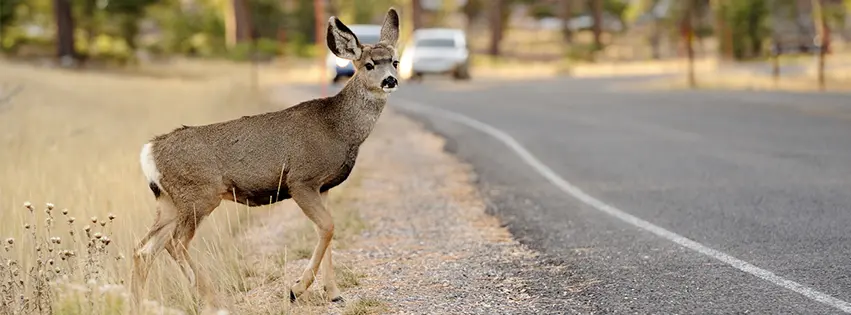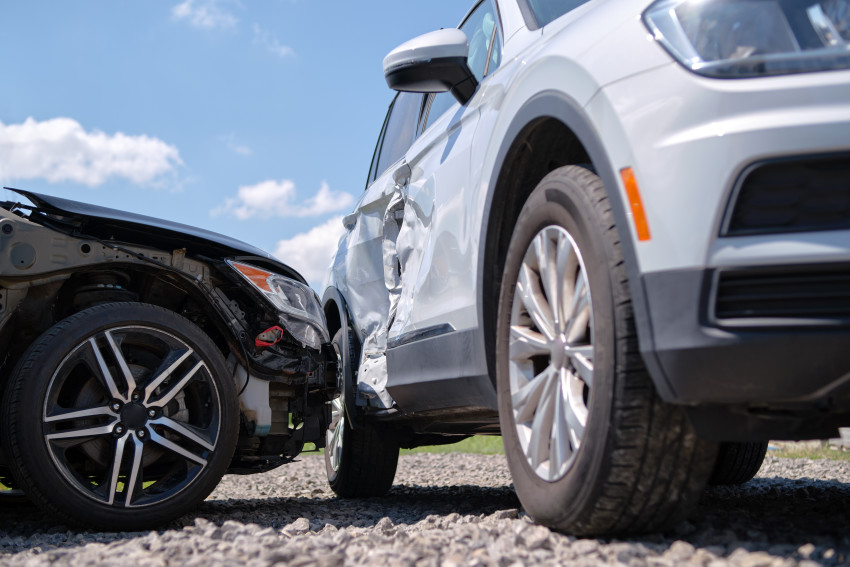
How To Avoid Deer Collisions When Driving
Whether you're shooing one away from your suburban backyard or counting the days until buck hunting season, deer pop into our lives in many ways—We’re in Tennessee after all! As harmless as they may seem, you really don't want one to pop up in the middle of the road while you’re driving.
October through early January marks deer breeding season, which is when they become most active. According to the Insurance Institute for Highway Safety, about 1.5 million deer-vehicle collisions occur in the United States each year. From these collisions, about 150 people are killed and another 29,000 are injured. That being said, here are some driving tips to keep you safe on the road as deer season gets into full swing.
5 Tips for Driving During Deer Season
1. Always Wear Your Seatbelt
An estimated 60% of fatalities caused by deer-vehicle collisions are caused by failure to wear a seatbelt. This is a tip that applies year-round, so always buckle up, folks.
2. Read the Road Signs
If you spot caution signs indicating deer or large animal crossings, use those brakes and drive a little slower. This will give you more time to react if you encounter a deer ahead, especially in heavily-wooded areas where they’re more common.
3. Be Extra Alert During Dawn and Dusk
You’re more likely to spot a deer around dawn and dusk, but stay alert at all times of the day. When driving at night, use your high beams to increase visibility—just remember to tone them down when you see oncoming traffic. This will give you more time to react if you spot a pair of shiny deer eyes up ahead.
4. Honk Your Horn to Scare Deer in Headlights
Deer tend to freeze or become mesmerized in the road when bright lights are approaching. If you spot a “deer in headlights” (we’ve all heard this phrase, right?), immediately slow down, flash your lights, and honk your horn to startle and scare the deer off the road.
5. Resist the Urge to Swerve
Never swerve to avoid a deer. Not only would this action confuse the deer on where it should run, but it could result in a head-on collision with oncoming traffic or a crash into roadside objects such as lamp posts or trees.
Also, remember the pack rule: If you see one deer crossing the road, a whole group usually follows. Swerving to avoid one deer could end with a collision into another.
5 Tips for Maintaining Good Visibility During Deer Season
Good visibility helps you anticipate potential hazards like deer crossing the road and react quickly to avoid accidents. Here are some practical tips to help you care for your car, improve visibility, and optimize lighting to reduce the risk of deer-related accidents.
1. Keep Your Windshield Clean and Clear:
Maintaining a clean windshield is key to having a clear view of the road. Regularly clean both the inside and outside of your windshield to remove dirt, dust, and streaks that can obstruct your vision. This is especially important during dusk or dawn, when deer activity tends to be higher. Also, don’t forget to replace worn-out wiper blades to ensure they effectively clear rain, snow, or debris that might hinder your visibility.
2. Check and Adjust Your Mirrors:
Your side and rearview mirrors are your allies in expanding your field of vision. Take a moment to properly adjust them before each journey. By doing so, you’ll reduce blind spots and increase your chances of spotting deer near the roadway. It’s a simple habit that can make a big difference in your overall visibility.
3. Optimize Headlight Performance
Regularly clean your headlights to remove dirt, grime, and oxidation that can dim their brightness and range. Ensure your headlights are correctly aligned to provide the best illumination without blinding other drivers. If you notice any misalignment, consult your vehicle’s manual or seek professional assistance to readjust them. Consider upgrading to LED or HID headlights. These options offer increased brightness compared to halogen bulbs.
4. Use Fog Lights Wisely
If you encounter foggy or misty conditions during deer season, fog lights can be helpful. They improve visibility close to the ground, where deer are more likely to be found. Remember to switch them off when visibility improves to avoid blinding oncoming drivers.
5. Maintain a Safe Distance
Keeping a safe distance between your vehicle and the one ahead is essential for good visibility and reaction time. During deer season, it’s even more crucial. By increasing your following distance, you’ll have more time to react if a deer suddenly appears on the road. It also reduces the risk of collision in case the vehicle in front of you stops abruptly or swerves to avoid a deer.
What To Do If You Strike a Deer...
If you do experience a deer-vehicle collision, call emergency services if injuries are involved. If no one is injured but damage has been caused to your property or someone else’s, contact your local police. Do not attempt to touch a deer that’s in or near the road, as a large animal with hooves can inflict some serious injuries. Report the incident to your insurance company as soon as possible.
Stay Protected on the Road with Farm Bureau Insurance of Tennessee
Farm Bureau Insurance offers comprehensive auto insurance policies that can provide you with the peace of mind and protection you need. Our dedicated local agents understand the unique risks associated with deer collisions and can help tailor a policy that suits your specific needs.
Tennessee Insurance: Read More

What is an Auto Deductible?
October 9, 2024
When it comes to auto insurance, understanding the terminology is crucial to making informed decisions about your coverage. One term that often comes up in discussions about car insurance is the “auto deductible.” Read more

What Is Business Insurance?
December 10, 2024
Whether you are a small business owner or a seasoned entrepreneur, having the right insurance coverage is crucial to protect your assets and mitigate various risks. In this article, we aim to provide you with an in-depth understanding of what business insurance is, its significance, and how it can contribute to your company's success. Read more

What's The Difference Between Term and Whole Life Insurance?
May 31, 2024
Life insurance is a crucial aspect of financial planning, offering peace of mind and financial security for your loved ones in the face of life's uncertainties. In this article, we'll explore the key differences between these two options. Read more
